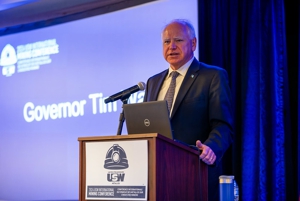8 Reasons College Athletes Need a Union
As was bound to happen, the NCAA replied with some boilerplate nonsense and confidence that it didn’t have to do anything else to compensate or protect players who make member schools billions of dollars a year:
The NCAA responded with a statement from Chief Legal Officer Donald Remy who said, “student-athletes are not employees within any definition of the National Labor Relations Act,” and that there is no existing employment relationships between the “NCAA, its affiliated institutions or student-athletes.”
“This union-backed attempt to turn student-athletes into employees undermines the purpose of college: an education,” Remy said in the statement. “Student-athletes are not employees, and their participation in college sports is voluntary. We stand for all student-athletes, not just those the unions want to professionalize.”
The labor movement was quick to endorse the players desire for a union. USW is the union of record on the paperwork the players submitted. The NFL Players Association (NFLPA) also expressed support for their college counterparts.
USW President Leo W. Gerard said:
Too many athletes who generate huge sums of money for their universities still struggle to pay for basic necessities, and too many live in fear of losing their scholarships due to injury or accident….These students deserve some assurance that when they devote weeks, months and years of their lives to an academic institution, that they will not be left out to dry, without the same basic protections that we all expect from the institutions we serve.
AFL-CIO President Richard Trumka alluded to the challenges college athletes face being part of the larger labor struggle:
The lesson that strength comes from standing together is one Colter has learned fulfilling his 60-hour-plus weeks as a football player, and it is true for all workers, whether they teach school, build Volkswagens in Chattanooga, [Tenn.,] or serve as home health care workers.
With that context in mind, here are eight reasons college athletes need a voice on the field:
1. Sports can kill you: There are many stories over the years of college and high school football players dying because of on-field or practice-related problems, particularly concussions, like the one that killed Frostburg State University player Derek Sheely last year. Many players don’t think the NCAA does enough to protect the safety of players, and the NCAA is on record saying that it has no legal obligation to protect players from head injuries. The NCPA has developed a safety plan it wants the NCAA to adopt.
2. The costs of a sports-related injury are not covered by the college: The NCAA doesn’t require schools to cover the costs that athletes incur when they are injured in relation to their sport. These injuries have left players with debts that can exceed $10,000, with many of those injuries reducing a player’s ability to earn money to pay for those costs.
3. An injury can end a player’s education: If a player gets injured, even through no fault of their own, they can be dropped by the college. Many colleges do the right thing and let them continue going to school, but it isn’t required.
4. Only half of football and men’s basketball players graduate: One of the key arguments against increased compensation for players is that they’re “getting a free education.” But an incomplete education doesn’t do a whole lot to expand the career options of the vast majority of players who don’t play professional sports. If schools don’t prioritize graduation for these players, are they really providing them with a free education? Or are they exploiting them for their talent and then casting them aside?
5. Athletic scholarships don’t cover all of a player’s costs: A recent study has shown that, on average, a college athlete’s scholarship leaves them about $3,200 short of the costs of attending college each year. Players are not allowed to receive pay for work to cover that cost.
6. Players who fail to live up to expectations can be cast aside: When a player takes a chance on signing to play with a school and they don’t live up to that school’s expectations, that player can lose their scholarship and lose their opportunity at finishing their education. The NCPA is calling for these players to be given given non-athletic scholarships so they can finish their degrees, since they sacrificed other opportunities by signing with the school that no longer wants them.
7. Colleges make billions off of players, who get a tiny piece of that pie: The power conferences in football and men’s basketball make an estimated $5.15 billion annually off of the players. Beyond scholarships, players get no compensation, despite the fact that schools not only make money off of the players for the games and TV contracts, but also off of merchandising, particularly in the form of apparel and video games (although there has been some limitation of this type of revenue in recent years).
8. Players don’t control their own destiny: If a player thinks they could be better served or have more opportunity at another school, they don’t have a ton of options. Most transfers require players to sit out a year and to lose a year of eligibility, unless they transfer to a lower division school that offers less visibility and can limit their future prospects in their sport.
***
This has been reposted from the AFL-CIO.
By clicking Sign Up you're confirming that you agree with our Terms and Conditions.
Related Blogs
Ready to make a difference?
Are you and your coworkers ready to negotiate together for bigger paychecks, stronger benefits and better lives?

